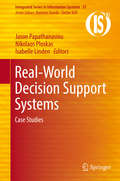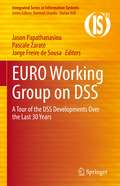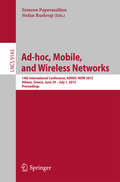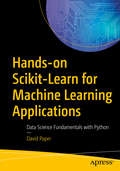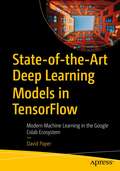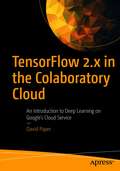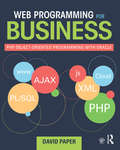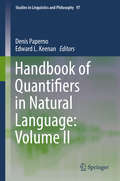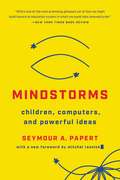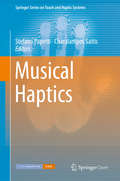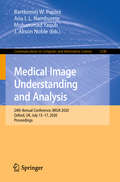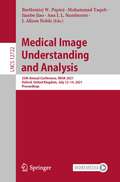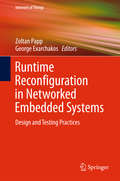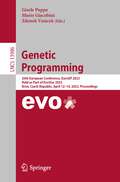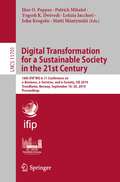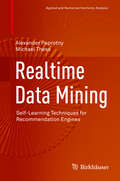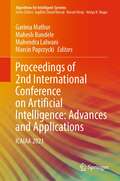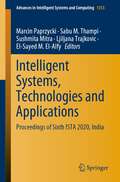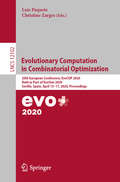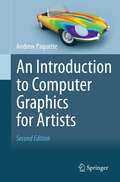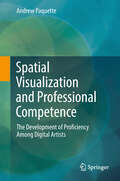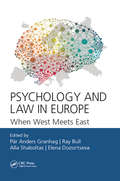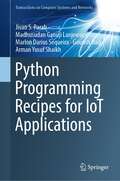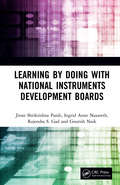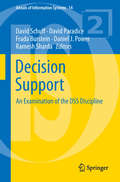- Table View
- List View
Real-World Decision Support Systems
by Jason Papathanasiou Nikolaos Ploskas Isabelle LindenThis book presents real-world decision support systems, i. e. , systems that have been running for some time and as such have been tested in real environments and complex situations; the cases are from various application domains and highlight the best practices in each stage of the system's life cycle, from the initial requirements analysis and design phases to the final stages of the project. Each chapter provides decision-makers with recommendations and insights into lessons learned so that failures can be avoided and successes repeated. For this reason unsuccessful cases, which at some point of their life cycle were deemed as failures for one reason or another, are also included. All decision support systems are presented in a constructive, coherent and deductive manner to enhance the learning effect. It complements the many works that focus on theoretical aspects or individual module design and development by offering 'good' and 'bad' practices when developing and using decision support systems. Combining high-quality research with real-world implementations, it is of interest to researchers and professionals in industry alike.
EURO Working Group on DSS: A Tour of the DSS Developments Over the Last 30 Years (Integrated Series in Information Systems)
by Jason Papathanasiou Pascale Zaraté Jorge Freire de SousaThis book recapitulates the major developments in Decision Support Systems (DSS) over the last 30 years in order to evaluate the research areas of decision making and in which direction the field should proceed. As it attempts to find a consensus about the next steps for the future of DSS research, the book also enforces the trends and new technologies currently in use. The book examines topics such as decision analysis for enterprise systems and non-hierarchical networks, integrated solutions for decision support and knowledge management in distributed environments, decision support system evaluation and analysis through social networks, and e-learning and its application to real environments. It clearly presents the evidence to support their cases and attempts to promote an extensive and objective discussion. In addition, the book also reflects on approaches to dead-end ideas and failures in DSS to better understand the lessons learned. The contributions for this book have been written by thought leaders and influential researchers from the EURO Working Group of Decision Support Systems (EWG-DSS).
Ad-hoc, Mobile, and Wireless Networks: 14th International Conference, ADHOC-NOW 2015, Athens, Greece, June 29 -- July 1, 2015, Proceedings (Lecture Notes in Computer Science #9143)
by Symeon Papavassiliou Stefan RuehrupThis book constitutes the proceedings of the 14th International Conference on Ad Hoc Networks and Wireless, ADHOC-NOW 2015, held in Athens, Greece in June/July 2015. The 25 full papers presented in this volume were carefully reviewed and selected from 52 submissions. The book also contains 3 full-paper invited talks. The contributions are organized in topical sections named: routing, connectivity, and resource allocation; localization, sensor deployment, and mobility management; distributed computing with mobile agents; efficient, reliable, and secure smart energy networks; and emerging communications, networking and computing technologies for VANETs 2. 0.
Hands-on Scikit-Learn for Machine Learning Applications: Data Science Fundamentals with Python
by David PaperAspiring data science professionals can learn the Scikit-Learn library along with the fundamentals of machine learning with this book. The book combines the Anaconda Python distribution with the popular Scikit-Learn library to demonstrate a wide range of supervised and unsupervised machine learning algorithms. Care is taken to walk you through the principles of machine learning through clear examples written in Python that you can try out and experiment with at home on your own machine.All applied math and programming skills required to master the content are covered in this book. In-depth knowledge of object-oriented programming is not required as working and complete examples are provided and explained. Coding examples are in-depth and complex when necessary. They are also concise, accurate, and complete, and complement the machine learning concepts introduced. Working the examples helps to build the skills necessary to understand and apply complex machine learning algorithms.Hands-on Scikit-Learn for Machine Learning Applications is an excellent starting point for those pursuing a career in machine learning. Students of this book will learn the fundamentals that are a prerequisite to competency. Readers will be exposed to the Anaconda distribution of Python that is designed specifically for data science professionals, and will build skills in the popular Scikit-Learn library that underlies many machine learning applications in the world of Python.What You'll LearnWork with simple and complex datasets common to Scikit-LearnManipulate data into vectors and matrices for algorithmic processingBecome familiar with the Anaconda distribution used in data scienceApply machine learning with Classifiers, Regressors, and Dimensionality ReductionTune algorithms and find the best algorithms for each datasetLoad data from and save to CSV, JSON, Numpy, and Pandas formatsWho This Book Is ForThe aspiring data scientist yearning to break into machine learning through mastering the underlying fundamentals that are sometimes skipped over in the rush to be productive. Some knowledge of object-oriented programming and very basic applied linear algebra will make learning easier, although anyone can benefit from this book.
State-of-the-Art Deep Learning Models in TensorFlow: Modern Machine Learning in the Google Colab Ecosystem
by David PaperUse TensorFlow 2.x in the Google Colab ecosystem to create state-of-the-art deep learning models guided by hands-on examples. The Colab ecosystem provides a free cloud service with easy access to on-demand GPU (and TPU) hardware acceleration for fast execution of the models you learn to build. This book teaches you state-of-the-art deep learning models in an applied manner with the only requirement being an Internet connection. The Colab ecosystem provides everything else that you need, including Python, TensorFlow 2.x, GPU and TPU support, and Jupyter Notebooks. The book begins with an example-driven approach to building input pipelines that feed all machine learning models. You will learn how to provision a workspace on the Colab ecosystem to enable construction of effective input pipelines in a step-by-step manner. From there, you will progress into data augmentation techniques and TensorFlow datasets to gain a deeper understanding of how to work with complex datasets. You will find coverage of Tensor Processing Units (TPUs) and transfer learning followed by state-of-the-art deep learning models, including autoencoders, generative adversarial networks, fast style transfer, object detection, and reinforcement learning. Author Dr. Paper provides all the applied math, programming, and concepts you need to master the content. Examples range from relatively simple to very complex when necessary. Examples are carefully explained, concise, accurate, and complete. Care is taken to walk you through each topic through clear examples written in Python that you can try out and experiment with in the Google Colab ecosystem in the comfort of your own home or office. What You Will LearnTake advantage of the built-in support of the Google Colab ecosystemWork with TensorFlow data setsCreate input pipelines to feed state-of-the-art deep learning modelsCreate pipelined state-of-the-art deep learning models with clean and reliable Python codeLeverage pre-trained deep learning models to solve complex machine learning tasksCreate a simple environment to teach an intelligent agent to make automated decisionsWho This Book Is ForReaders who want to learn the highly popular TensorFlow deep learning platform, those who wish to master the basics of state-of-the-art deep learning models, and those looking to build competency with a modern cloud service tool such as Google Colab
TensorFlow 2.x in the Colaboratory Cloud: An Introduction to Deep Learning on Google’s Cloud Service
by David PaperUse TensorFlow 2.x with Google's Colaboratory (Colab) product that offers a free cloud service for Python programmers. Colab is especially well suited as a platform for TensorFlow 2.x deep learning applications. You will learn Colab’s default install of the most current TensorFlow 2.x along with Colab’s easy access to on-demand GPU hardware acceleration in the cloud for fast execution of deep learning models. This book offers you the opportunity to grasp deep learning in an applied manner with the only requirement being an Internet connection. Everything else—Python, TensorFlow 2.x, GPU support, and Jupyter Notebooks—is provided and ready to go from Colab. The book begins with an introduction to TensorFlow 2.x and the Google Colab cloud service. You will learn how to provision a workspace on Google Colab and build a simple neural network application. From there you will progress into TensorFlow datasets and building input pipelines in support of modeling and testing. You will find coverage of deep learning classification and regression, with clear code examples showing how to perform each of those functions. Advanced topics covered in the book include convolutional neural networks and recurrent neural networks. This book contains all the applied math and programming you need to master the content. Examples range from simple to relatively complex when necessary to ensure acquisition of appropriate deep learning concepts and constructs. Examples are carefully explained, concise, accurate, and complete to perfectly complement deep learning skill development. Care is taken to walk you through the foundational principles of deep learning through clear examples written in Python that you can try out and experiment with using Google Colab from the comfort of your own home or office.What You Will LearnBe familiar with the basic concepts and constructs of applied deep learningCreate machine learning models with clean and reliable Python codeWork with datasets common to deep learning applicationsPrepare data for TensorFlow consumptionTake advantage of Google Colab’s built-in support for deep learningExecute deep learning experiments using a variety of neural network modelsBe able to mount Google Colab directly to your Google Drive accountVisualize training versus test performance to see model fitWho This Book Is ForReaders who want to learn the highly popular TensorFlow 2.x deep learning platform, those who wish to master deep learning fundamentals that are sometimes skipped over in the rush to be productive, and those looking to build competency with a modern cloud service tool such as Google Colab
Web Programming for Business: PHP Object-Oriented Programming with Oracle
by David PaperWeb Programming for Business: PHP Object-Oriented Programming with Oracle focuses on fundamental PHP coding, giving students practical, enduring skills to solve data and technical problems in business. Using Oracle as the backend database, the book is version-neutral, teaching students code that will still work even with changes to PHP and Oracle. The code is clean, clearly explained and solutions-oriented, allowing students to understand how technologies such as XML, RSS or AJAX can be leveraged in business applications. The book is fully illustrated with examples, and includes chapters on: Database functionality Security programming Transformation programming to move data Powerpoint slides, applied exam questions, and the raw code for all examples are available on a companion website. This book offers an innovative approach that allows anyone with basic SQL and HTML skills to learn PHP object-oriented programming.
Handbook of Quantifiers in Natural Language: Volume II
by Denis Paperno Edward L. KeenanThis work presents the structure, distribution and semantic interpretation of quantificational expressions in languages from diverse language families and typological profiles. The current volume pays special attention to underrepresented languages of different status and endangerment level. Languages covered include American and Russian Sign Languages, and sixteen spoken languages from Africa, Australia, Papua, the Americas, and different parts of Asia. The articles respond to a questionnaire the editors constructed to enable detailed crosslinguistic comparison of numerous features. They offer comparable information on semantic classes of quantifiers (generalized existential, generalized universal, proportional, partitive), syntactically complex quantifiers (intensive modification, Boolean compounds, exception phrases, etc. ), and several more specific issues such as quantifier scope ambiguities, floating quantifiers, and binary (type 2) quantifiers. The book is intended for semanticists, logicians interested in quantification in natural language, and general linguists as articles are meant to be descriptive and theory independent. The book continues and expands the coverage of the Handbook of Quantifiers in Natural Language (2012) by the same editors, and extends the earlier work in Matthewson (2008), Gil et al. (2013) and Bach et al (1995).
Mindstorms: Children, Computers, And Powerful Ideas
by Seymour A. PapertIn this revolutionary book, a renowned computer scientist explains the importance of teaching children the basics of computing and how it can prepare them to succeed in the ever-evolving tech world.Computers have completely changed the way we teach children. We have Mindstorms to thank for that. In this book, pioneering computer scientist Seymour Papert uses the invention of LOGO, the first child-friendly programming language, to make the case for the value of teaching children with computers. Papert argues that children are more than capable of mastering computers, and that teaching computational processes like de-bugging in the classroom can change the way we learn everything else. He also shows that schools saturated with technology can actually improve socialization and interaction among students and between students and teachers.Technology changes every day, but the basic ways that computers can help us learn remain. For thousands of teachers and parents who have sought creative ways to help children learn with computers, Mindstorms is their bible.
Musical Haptics (Springer Series on Touch and Haptic Systems)
by Stefano Papetti Charalampos SaitisThis open access book offers an original interdisciplinary overview of the role of haptic feedback in musical interaction. Divided into two parts, part I examines the tactile aspects of music performance and perception, discussing how they affect user experience and performance in terms of usability, functionality and perceived quality of musical instruments. Part II presents engineering, computational, and design approaches and guidelines that have been applied to render and exploit haptic feedback in digital musical interfaces. Musical Haptics introduces an emerging field that brings together engineering, human-computer interaction, applied psychology, musical aesthetics, and music performance. The latter, defined as the complex system of sensory-motor interactions between musicians and their instruments, presents a well-defined framework in which to study basic psychophysical, perceptual, and biomechanical aspects of touch, all of which will inform the design of haptic musical interfaces. Tactile and proprioceptive cues enable embodied interaction and inform sophisticated control strategies that allow skilled musicians to achieve high performance and expressivity. The use of haptic feedback in digital musical interfaces is expected to enhance user experience and performance, improve accessibility for disabled persons, and provide an effective means for musical tuition and guidance.
Medical Image Understanding and Analysis: 24th Annual Conference, MIUA 2020, Oxford, UK, July 15-17, 2020, Proceedings (Communications in Computer and Information Science #1248)
by Bartłomiej W. Papież Ana I. L. Namburete Mohammad Yaqub J. Alison NobleThis book constitutes the refereed proceedings of the 24th Conference on Medical Image Understanding and Analysis, MIUA 2020, held in July 2020. Due to COVID-19 pandemic the conference was held virtually. The 29 full papers and 5 short papers presented were carefully reviewed and selected from 70 submissions. They were organized according to following topical sections: image segmentation; image registration, reconstruction and enhancement; radiomics, predictive models, and quantitative imaging biomarkers; ocular imaging analysis; biomedical simulation and modelling.
Medical Image Understanding and Analysis: 25th Annual Conference, MIUA 2021, Oxford, United Kingdom, July 12–14, 2021, Proceedings (Lecture Notes in Computer Science #12722)
by Bartłomiej W. Papież Mohammad Yaqub Jianbo Jiao Ana I. L. Namburete J. Alison NobleThis book constitutes the refereed proceedings of the 25th Conference on Medical Image Understanding and Analysis, MIUA 2021, held in July 2021. Due to COVID-19 pandemic the conference was held virtually. The 32 full papers and 8 short papers presented were carefully reviewed and selected from 77 submissions. They were organized according to following topical sections: biomarker detection; image registration, and reconstruction; image segmentation; generative models, biomedical simulation and modelling; classification; image enhancement, quality assessment, and data privacy; radiomics, predictive models, and quantitative imaging.
Runtime Reconfiguration in Networked Embedded Systems
by Zoltan Papp George ExarchakosThisbook focuses on the design and testing of large-scale, distributed signalprocessing systems, with a special emphasis on systems architecture, toolingand best practices. Architecture modeling, model checking, model-basedevaluation and model-based design optimization occupy central roles. Targetsystems with resource constraints on processing, communication or energy supplyrequire non-trivial methodologies to model their non-functional requirements,such as timeliness, robustness, lifetime and "evolution" capacity. Besides thetheoretical foundations of the methodology, an engineering process andtoolchain are described. Real-world cases illustrate the theory and practicetested by the authors in the course of the Europeanproject ARTEMIS DEMANES. The book can be used as a "cookbook" for designers andpractitioners working with complex embedded systems like sensor networks for thestructural integrity monitoring of steel bridges, and distributed micro-climatecontrol systems for greenhouses and smart homes.
Genetic Programming: 26th European Conference, EuroGP 2023, Held as Part of EvoStar 2023, Brno, Czech Republic, April 12–14, 2023, Proceedings (Lecture Notes in Computer Science #13986)
by Gisele Pappa Mario Giacobini Zdenek VasicekThis book constitutes the refereed proceedings of the 26th European Conference on Genetic Programming, EuroGP 2023, held as part of EvoStar 2023, in Brno, Czech Republic, during April 12–14, 2023, and co-located with the EvoStar events, EvoCOP, EvoMUSART, and EvoApplications. The 14 revised full papers and 8 short papers presented in this book were carefully reviewed and selected from 38 submissions. The wide range of topics in this volume reflects the current state of research in the field. The collection of papers cover topics including developing new variants of GP algorithms for both optimization and machine learning problems as well as exploring GP to address complex real-world problems.
Digital Transformation for a Sustainable Society in the 21st Century: 18th IFIP WG 6.11 Conference on e-Business, e-Services, and e-Society, I3E 2019, Trondheim, Norway, September 18–20, 2019, Proceedings (Lecture Notes in Computer Science #11701)
by Ilias O. Pappas Patrick Mikalef Yogesh K. Dwivedi Letizia Jaccheri John Krogstie Matti MäntymäkiThis book constitutes the proceedings of the 18th IFIP WG 6.11 Conference on e-Business, e-Services, and e-Society, I3E 2019, held in Trondheim, Norway, in September 2019. The total of 61 full and 4 short papers presented in this volume were carefully reviewed and selected from 138 submissions. The papers were organized in topical sections named: e-business; big data analytics, open science and open data; artificial intelligence and internet of things; smart cities and smart homes, social media and analytics; digital governance; digital divide and social inclusion; learning and education; security in digital environments; modelling and managing the digital enterprise; digital innovation and business transformation; and online communities.
Realtime Data Mining
by Alexander Paprotny Michael ThessDescribing novel mathematical concepts for recommendation engines, Realtime Data Mining: Self-Learning Techniques for Recommendation Engines features a sound mathematical framework unifying approaches based on control and learning theories, tensor factorization, and hierarchical methods. Furthermore, it presents promising results of numerous experiments on real-world data. The area of realtime data mining is currently developing at an exceptionally dynamic pace, and realtime data mining systems are the counterpart of today's "classic" data mining systems. Whereas the latter learn from historical data and then use it to deduce necessary actions, realtime analytics systems learn and act continuously and autonomously. In the vanguard of these new analytics systems are recommendation engines. They are principally found on the Internet, where all information is available in realtime and an immediate feedback is guaranteed. This monograph appeals to computer scientists and specialists in machine learning, especially from the area of recommender systems, because it conveys a new way of realtime thinking by considering recommendation tasks as control-theoretic problems. Realtime Data Mining: Self-Learning Techniques for Recommendation Engines will also interest application-oriented mathematicians because it consistently combines some of the most promising mathematical areas, namely control theory, multilevel approximation, and tensor factorization.
Proceedings of 2nd International Conference on Artificial Intelligence: ICAIAA 2021 (Algorithms for Intelligent Systems)
by Marcin Paprzycki Mahesh Bundele Garima Mathur Mahendra LalwaniThis book gathers outstanding research papers presented in the 2nd International Conference on Artificial Intelligence: Advances and Application (ICAIAA 2021), held in Poornima College of Engineering, Jaipur, India during 27-28 March 2021. This book covers research works carried out by various students such as bachelor, master and doctoral scholars, faculty and industry persons in the area of artificial intelligence, machine learning, deep learning applications in healthcare, agriculture, business, security, etc. It will also cover research in core concepts of computer networks, intelligent system design and deployment, real time systems, WSN, sensors and sensor nodes, SDN, NFV, etc.
Intelligent Systems, Technologies and Applications: Proceedings of Sixth ISTA 2020, India (Advances in Intelligent Systems and Computing #1353)
by Marcin Paprzycki Sabu M. Thampi Sushmita Mitra Ljiljana Trajkovic El-Sayed M. El-AlfyThis book offers to readers a selection of refereed papers that were presented at the Sixth International Symposium on Intelligent Systems Technologies and Applications (ISTA’20). All submissions were evaluated on the basis of their significance, novelty, and technical quality. This book consists of 28 papers (19 regular and 9 short papers) that were virtually presented at the Symposium. The papers cover different areas such as big data analytics, security and privacy, Internet of things, machine and deep learning, health informatics, visual computing, signal processing, and natural language processing. The book is directed to the researchers and scientists engaged in various fields of intelligent systems.
Evolutionary Computation in Combinatorial Optimization: 20th European Conference, EvoCOP 2020, Held as Part of EvoStar 2020, Seville, Spain, April 15–17, 2020, Proceedings (Lecture Notes in Computer Science #12102)
by Luís Paquete Christine ZargesThis book constitutes the refereed proceedings of the 20th European Conference on Evolutionary Computation in Combinatorial Optimization, EvoCOP 2020, held as part of Evo*2020, in Seville, Spain, in April 2020, co-located with the Evo*2020 events EuroGP, EvoMUSART and EvoApplications.The 14 full papers presented in this book were carefully reviewed and selected from 37 submissions. The papers cover a wide spectrum of topics, ranging from the foundations of evolutionary computation algorithms and other search heuristics, to their accurate design and application to combinatorial optimization problems.
An Introduction to Computer Graphics for Artists
by Andrew PaquetteAn Introduction to Computer Graphics for Artists is an application-independent, reader-friendly primer for anyone with a serious desire to understand 3D Computer Graphics. Written by a veteran of the computer graphics industry whose previous career included film animation and various spells as Art Director for video games, Andrew Paquette draws on his experiences both as an artist and a manager. Far too often artists, even professionals, lack a basic understanding of the principles of computer graphics. The result is inefficiency and lower quality of work. This book addresses these issues by providing fundamental information in a university course format, with theoretical material, detailed illustrations, and projects to test the reader's understanding of the concepts covered. Opening with the first and most basic elements of computer graphics, the book rapidly advances into progressively more complex concepts. Each of the elements, however simple, are important to understand because each is an essential link in a chain that allows an artist to master any computer graphics application. With this accomplished, the artist can use technology to satisfy his goals, instead of the technology being master of the artist. All students wanting to learn more about computer graphics from an artistic viewpoint, particularly those intending to pursue a career in computer game design or film animation, will find this book invaluable.
Spatial Visualization and Professional Competence: The Development Of Proficiency Among Digital Artists
by Andrew PaquetteThe computer graphics (CG) industry is an attractive field for undergraduate students, but employers often find that graduates of CG art programmes are not proficient. The result is that many positions are left vacant, despite large numbers of job applicants. This book investigates how student CG artists develop proficiency. The subject is important to the rapidly growing number of educators in this sector, employers of graduates, and students who intend to develop proficiency for the purpose of obtaining employment. Educators will see why teaching software-oriented knowledge to students does not lead to proficiency, but that the development of problem-solving and visualisation skills do. This book follows a narrow focus, as students develop proficiency in a cognitively challenging task known as ‘NURBS modelling’. This task was chosen due to an observed relationship between students who succeeded in the task, and students who successfully obtained employment after graduation. In the study this is based on, readers will be shown that knowledge-based explanations for the development of proficiency do not adequately account for proficiency or expertise in this field, where visualisation has been observed to develop suddenly rather than over an extended period of time. This is an unusual but not unique observation. Other studies have shown rapid development of proficiency and expertise in certain professions, such as among telegraph operators, composers and chess players. Based on these observations, the book argues that threshold concepts play a key role in the development of expertise among CG artists.
Psychology and Law in Europe: When West Meets East
by Pär Anders Granhag, Ray Bull, Alla Shaboltas and Elena DozortsevaOffering carefully curated articles from the European Association of Psychology and Law (EAPL), this book features chapters from a truly international group of scholars. This text is the first of its kind to offer insights into current developments in psychology and law in Russia. The field of psychology and law has a very long and strong tradition in Russia, but very little is known, as Russian scholars rarely publish their works in English. The volume also contains state-of-the-art chapters on topics at the very core of psychology and law, including offender profiling, lie detection, crime linking, false memories, and witness interviewing. Features Provides rare insight into Russian history of forensic and criminal psychology Covers core topics in the discipline Offers international scope from a diverse array of contributors Psychology and Law in Europe: When West Meets East is a text of interest for students of psychology, law, or criminal justice, as well as scholars and practitioners in the field. This text offers a window into global advances in psychology and law.
Python Programming Recipes for IoT Applications (Transactions on Computer Systems and Networks)
by Jivan S. Parab Madhusudan Ganuji Lanjewar Marlon Darius Sequeira Gourish Naik Arman Yusuf ShaikhThe book comprehensively covers the most important applications of the internet of things (IoT) using Python programming on Raspberry pi, Micropython Py Board, and NVIDIA Jetson Board. The authors have used an immersive ‘hands-on’ approach to help readers gain expertise in developing working code for real-world IoT applications. The book focuses on industry-standard embedded platforms for IoT applications. It also gives a glimpse of python programming and setup configuration of these embedded platforms. The later chapter highlights basic interface applications with Raspberry Pi. Exclusive advanced IoT applications on the Micropython Pyboard are also covered. The last two chapters deal with the NVIDIA Jetson Nano board programming for machine learning applications with FoG/cloud computing. The various IoT applications with different embedded platforms in this volume are best-suited for undergraduate/postgraduate students and researchers who want to get exposed to python programming for IoT applications. This book will enable readers to design their own embedded IoT products.
Learning by Doing with National Instruments Development Boards
by Jivan Shrikrishna Parab Ingrid Anne Nazareth Rajendra S. Gad Gourish NaikLearning by Doing with National Instruments Development Boards starts with a brief introduction to LabVIEW programming, which is required to explore the National Instrument platform, an introduction that includes detailed installation and licensing setup. Further, it gives the features and configuration setup of NI SPEEDY-33, NI ELVIS and myRIO boards. The focus of the book is on worked-out case studies for students working in different areas of electronics such as basic digital design, biomedical instrumentation, sensors and measurement. Data acquisition using SPEEDY-33, NI –ELVIS and myRIO kits is also odiscussed. The book also examines the myRIO platform.
Decision Support
by David Paradice Ramesh Sharda Daniel J. Power David Schuff Frada BursteinThis volume of Annals of Information Systems will acknowledge the twentieth anniversary of the founding of the International Society for Decision Support Systems (ISDSS) by documenting some of the current best practices in teaching and research and envisioning the next twenty years in the decision support systems field. The volume is intended to complement existing DSS literature by offering an outlet for thoughts and research particularly suited to the theme of describing the next twenty years in the area of decision support. Several subthemes are planned for the volume. One subtheme draws on the assessments of internationally known DSS researchers to evaluate where the field has been and what has been accomplished. A second subtheme of the volume will be describing the current best practices of DSS research and teaching efforts. A third subtheme will be an assessment by top DSS scholars on where the DSS discipline needs to focus in the future. The tone of this volume is one of enthusiasm for the potential contributions to come in the area of DSS; contributions that must incorporate an understanding of what has been accomplished in the past, build on the best practices of today, and be be integrated into future decision making practices. The primary questions raised by this volume are: What will information systems-based decision support entail in twenty years? What research is needed to realize the envisioned future of information systems-based decision support? How will the teaching of information systems-based decision support change over the next twenty years? What are the best practices of teaching in the decision support area that can be leveraged to best disseminate DSS knowledge advances to students and practitioners?
